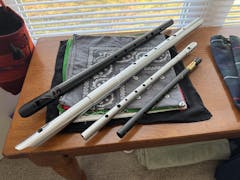Collection: Bagpipes
I will leave the history of bagpipes to the experts. Instead, this will be a general guide to bagpipes.
IRELAND
The Irish Union or Uilleann (pronounced ill-an pipes have a 2-octave range. If fitted with...
I will leave the history of bagpipes to the experts. Instead, this will be a general guide to bagpipes.
IRELAND
The Irish Union or Uilleann (pronounced ill-an pipes have a 2-octave range. If fitted with four keys it is capable of all the chromatic intervals though the music seldom calls for most of the 'extra' notes. The C- and F-natural keys are the two most desirable additions. The uilleann pipes have three drones tuned to D in three octaves and three keyed pipes in the drone stock called regulators which are played with the wrist for rhythmic and chordal accompaniment. The pipes are bellows blown. Modern sets are in concert D pitch, which play well in the keys of D, G, and Em. Certain tunes in other keys (A, Am, Bm, etc.) are also possible. A relatively quiet pipe, they blend well with fiddle, flute and whistle. The older irish pipes were pitched lower at C, B or B-flat. These were quieter than the ones pitched in D due to the smaller bores. They might make a better acoustic blend with a harp but fiddlers would have to tune down to them. There are many good makers of Irish pipes in new and old pitch. Your best bet with reeds for these pipes is to learn to make them yourself.
Irish warpipes. There do not seem to be any surviving examples of the old pipes of Ireland. They died out about the middle of the 18th century. In the late 19th century there was a revival using what was basically a Highland pipe with one less tenor drone. This practice continued up to today in Irish pipe bands. Considering the similarity in instruments between Ireland and Scotland (the Trinity and Queen Mary harps, for example) it is highly likely the pipes were also quite similar. The irish warpipes of modern make are available in B-flat with one bass and one tenor drone. The chanter uses the same scale and fingering as Scottish pipes. Ready-made reeds are available.
SCOTLAND
Highland Pipes. You know about these, of course. They are made and played all over the world. The old pipes were slightly lower in pitch: at about A. Highland pipes today are made in B-flat [and climbing] with three drones--a bass and two tenors tuned to B-flat. The chanters on these (and Irish warpipes) are limited to 9 notes. Most people learning to play will start out with a practice chanter, which eliminates learning to work the chanter, drones and bag at the outset. Ready-made reeds for the practice chanter and Highland pipes are available.
Lowland pipes were made in southern Scotland and are bellows blown. The chanter is fingered like the highland chanter and uses the same scale. The three drones emanate from a single stock and are tuned like highland drones. Being bellows blown they use a softer reed and smaller bores, which results in a much quieter sound than the highland pipes, good for ensemble playing. New sets are available in B-flat, G or A. Ready-made reeds are also available for most of these pipes.
Scottish smallpipes are quiet cylindrically bored pipes. They are commonly bellows blown but also exist in mouth blown form. Very similar in tone to Northumbrian Pipes but the open ended chanter and playing style makes them sound a little different. They are usually fingered as a Highland pipe would be though they are more forgiving in that regard due to the bore. [cylindrical bores are not affected by cross fingerings] These pipes are made in the keys of: A,B flat, C, and D.
ENGLAND
Two reproductions from paintings of the Old English mouth-blown pipes have been developed but there seem to be no surviving originals. Both styles had two drones pitched in G.
Northumbrian pipes have had a long unbroken tradition in northern England. The old style had a keyless, close-ended chanter and three drones pitched at F. Later styles have chanters with 7-17 keys giving a great range and 4 drones used in various combinations and tunings making it possible to play in several keys. A quiet, pleasing pipe. The drones are tuned to the tonic in two octaves with a fifth between. New sets are available in ÔFÕ, concert G concert D, which is a slightly lower pitched set. Old sets and those based on old sets are not in concert F.Some ready-made reeds are available, although it is best to make your own.
FRANCE
The mussette [cornemuse is a general term as in ÔbagpipeÕ] is a mouth-blown bagpipe with two drones: a tenor in a common stock with the chanter and a bass over the shoulder. The chanter plays a standard scale with a leading tone 1/2 step below the tonic [7th] and cross-fingerings allowing several accidentals. It overblows a fourth into the upper octave.mussettes are commonly madein the keys of B-flat, A, G, and D. The most popular keys are G and D, the keys most compatible with common hurdy-gurdy tunings. Not especiallyloud for a mouth-blown pipe, the cornemuse is a good ensemble instrument.Some french made reeds are available but, as with all of the less common pipes it is best to learn to make your reeds.
The Cabrette is a bellows or mouth-blown pipe with one small drone in a common stock with the chanter. Originating in Auvergne, this pipe has spread throughout France because of its relatively easy maintenance and playability. The key of G is most commonly found, but they are also made in other keys. The drone is tuned to the tonic. These pipes overblow into the second octave, making it possible to play the many C tunes from Auvergne. Since the cabrette is played so often with the hurdy-gurdy (where the drones can be quite dominant), or in groups, many players do not use the drone.
Musette du Cour. An 18th century court instrument, the musette is the grandfather ofthe northumbrian pipe. The musette has one small, keyed chanter in F or D and a second small chanter alongside with 6 keys extending the range upwards. The musette uses three drones, same as the northumbrian pipes and tuned the same way: tonic,fifth,tonic (next octave). All the drones are bored into one piece of wood like a renaissance rackett. 6-8 slides offer a choice of drone tunings. The musette has a quiet, pretty sound. Reproductions are available in F and D. With these pipes, the reeds are of the make-it-yourself variety. France has at least fifteen different native bagpipes. Why were the Scots satisfied with only three?
BRITTANY
Biniou Koz. The best known bagpipes of Brittany. Biniou koz means old bagpipe, probably named as a reaction to the highland pipe which was introduced as the 'grand biniou' in the 1940's. The grand biniou almost replaced the biniou but a revival is making the older pipes heard again. The biniou is in B-flat, an octave about the highland pipe chanter. It has one drone, is mouth-blown and is very high pitched. The biniou is commonly teamed with the bombarde, a loud reed instrument in B-flat. The call-and-answer style of playing is very interesting, as are the haunting melodies of the
The Veuze is a lower pitched pipe in C, B-flat, A or G. One drone is most common in old pictures but two-drone models are also available. These pipes are mouth-blown. The available literature makes no mention of bombardes being used with the veuze; however, it would be possible with an instrument pitched in B-flat or C.
SPAIN
Gaita. The Spanish pipes are available in three keys: B-flat, C and D. They are mouth-blown (though bellows are sometimes used) with a bass drone. Some models have a tenor drone; some have a ronquillo drone as a substitute for the tenor. The ronquillo uses a double reed (as in the chanter) and sounds a 12th above the tonic. The Spanish pipes, being smaller and supporting fewer drones than the Scots pipes are relatively easy to blow. They tend to be dependable and easy to maintain. Many gaita chanters can be fitted with slightly modified (thinner and shortened) highland pipe reeds.
ITALY
Zampogna. These pipes are used in Italy and Sicily. The larger models use all double reeds. They have two chanters and two drones in a common stock. Often the small drone is a dummy. Some larger models have chanters in octaves and are used to back up the piffaro (shawm) or singing. Other models have chanters of the same size tuned in fourths. These are for solo use and capable or playing the entire melody between the two chanters. The larger models in common use are pitched in F, G or A although some huge zampognas are made in Italy. Smaller zampognas use single reeds throughout. In these, pitches may be as high as B-flat. The smaller zampognas use chanters tuned in fourths. Zampognas require constant adjustment but the beautiful harmonies they produce with their double chanters and drones sounding the fifth are worth any amount of fussing. Make your own reeds--these pipes are very forgiving and respond to various patterns of reeds. This isnÕt to say they are easy to keep in tune. Using three to five double reeds in a mouth blown pipe is makes for an ever changing pitch problem. Plastic reeds have been used with some success.
The Piva is extinct in its northern Italian home and appropriate music may be hard to come by but reproductions are available. The piva consists of one chanter and one drone. Some makers use a double reed chanter and some use single reed. These pipes are very small and easy blowing.
EASTERN EUROPE
Bulgarian Gaida. The single bass drone and chanter both employ single reeds. These are easy to blow but hard to play well. They are made in D and G, often sold with one chanter in each key and an extra drone so that one set can be used for music in both keys. The gaida uses a goatskin bag. Reeds are generally made by the player. This is a fantastic instrument in the right hands.
Macedonian Gaida. Similar in basic form to the bulgarian gaida, it has one bass drone and a chanter, is mouth-blown and pitched in B-flat or A.
The Hungarian Duda has a bass drone with a horn on the end. The chanter and tenor drone are bored into the same piece of wood with a fingerhole in the drone bore allowing two drone notes. The stock that holds the chanter/drone is invariably a large carving of a goat head. A very picturesque bagpipe in the key of A. It can be either mouth- or bellows-blown.
Polish Koza. The Polish pipes are more related in appearance to some old german pipes. It uses a large goatskin bag (hair out) and a single reed chanter, cylindrical bore and deep pitch, with a large horn and brass bell at the end. The bass drone typically has the same bell. It is usually bellows-blown and produces a mellow, low pitch. A carved goatshead stock similar to the duda is common. The single reeds are often made of a cane blade lapped onto copper tubing.
EARLY BAGPIPES
Flemish. In paintings of Bruegal and Teniers we see the renaissance pipers playing an instrument with two drones in a common stock. The relative lengths of the drone suggests they were tuned in fifths (a very pleasing drone chord). No pipes of this type survived. Most modern reproductions are made in the keys of F or G. Some sets use commercially available reeds. Some sets are "make-your-own".
The Medieval bagpipes were either a chanter only (no drone) or with one bass drone. While it is probable that some of the pipes of this time had single reed chanters, the frequency of the conical shaped chanter and vent holes make the likelihood of double reeds stronger. In later times we see statuary with double chanters and a bass drone. Reproductions of medieval pipes are available with various types of reeds. Some claim that medieval can only have been one and one drone have failed to take into consideration the fact that Nero minted a coin in 57 A.D. on which a double chantered bagpipe and bellows was embossed.
Space, availability and knowledge prevent me from going much further--into the many more bagpipes found on the continent and North Africa. If I've left out your favorite pipe bear in mind that I'm only a volunteer!
-Denny Hall
Looking for accessories? Check out our Bagpipe Accessories collection!
-
 Sold out
Sold outBladderpipe
SKU: bag199
Regular price $470.00Regular priceUnit price / per$495.00Sale price $470.00Sold out






